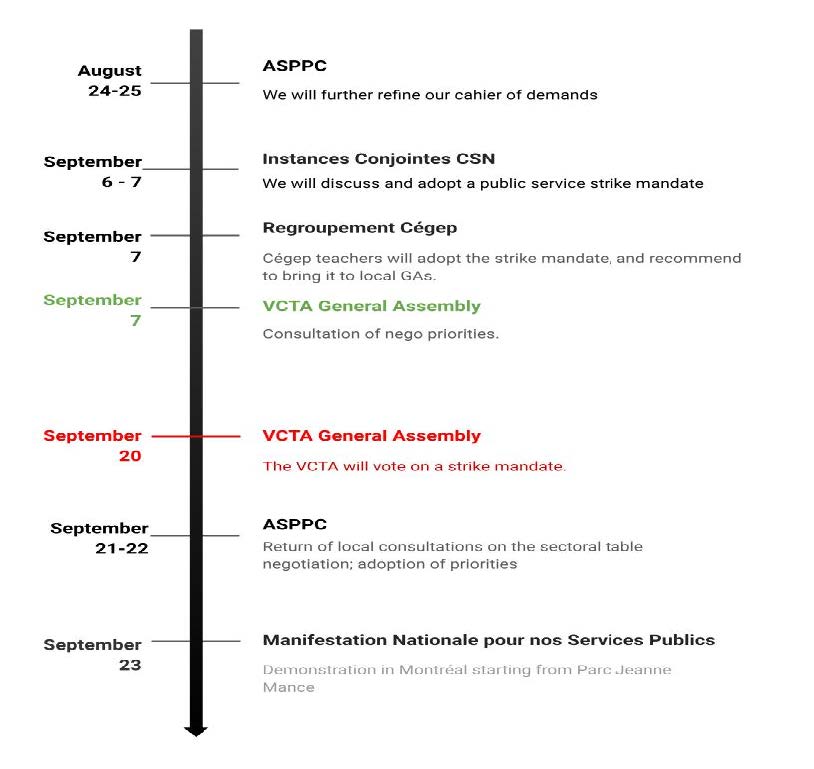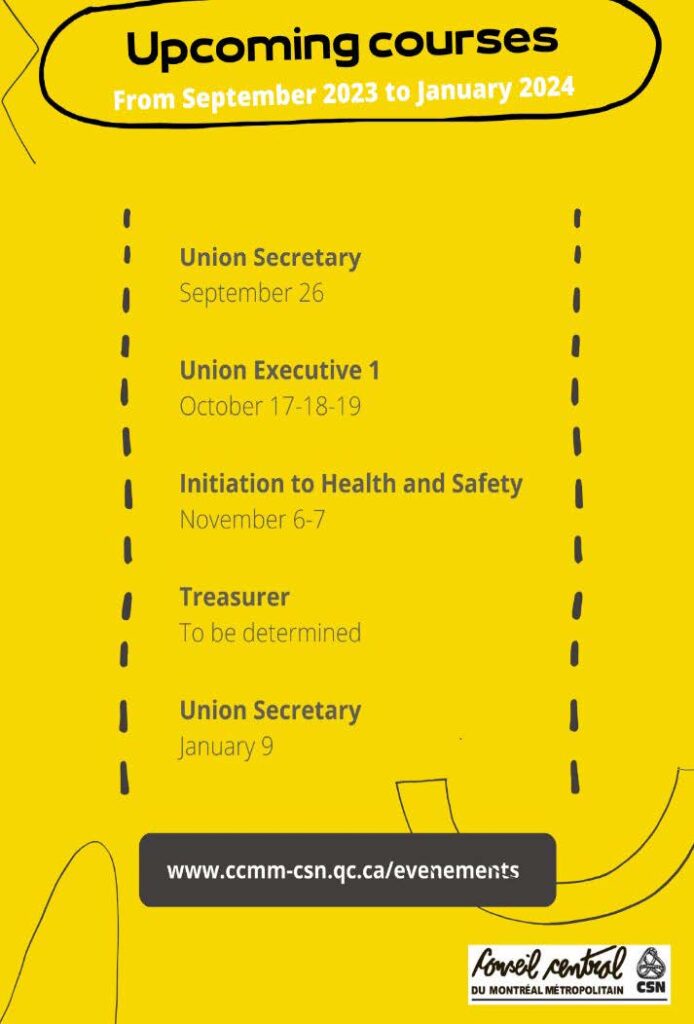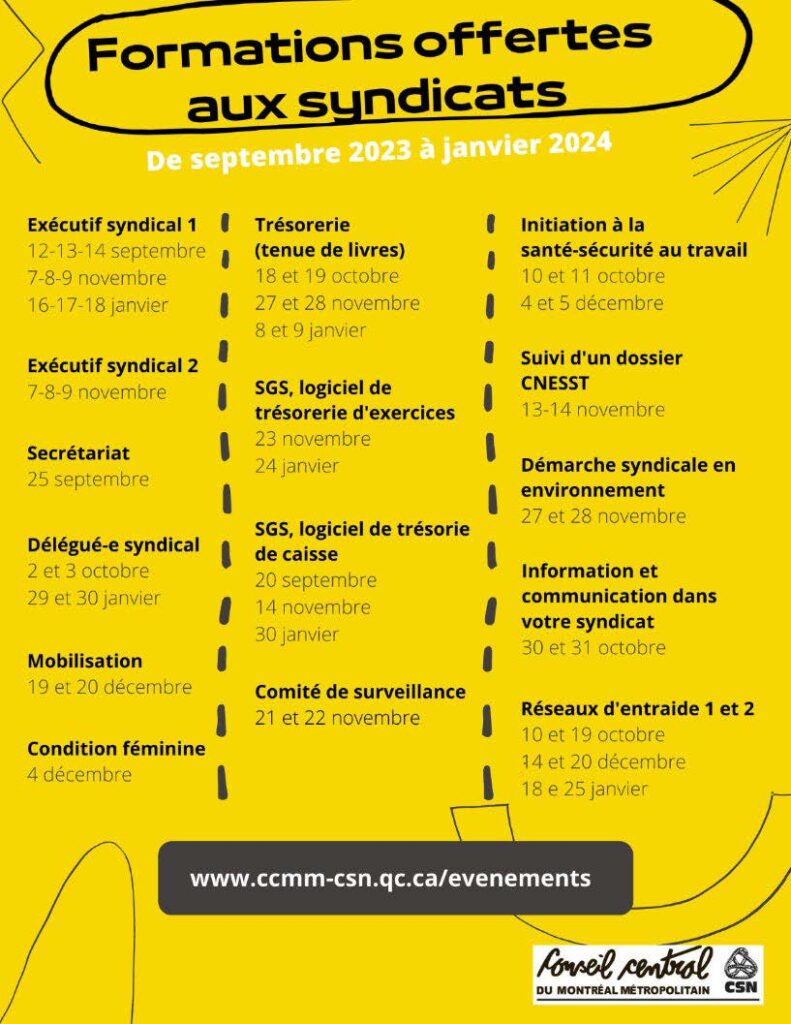Welcome Back The VCTA would like to welcome teachers back to Vanier for the 2023-2024 academic year! We hope that your semester is off to a great start!
As always, you can visit us in C-101. Our office hours are posted on the door and on our website, https://www.thevcta.qc.ca/
Come see us if you have any questions regarding workloads, seniority and priority, insurance plans, retirement, scholarity, and anything else related to working at Vanier. In particular, before turning down work we encourage you to come and discuss the implications with us.
You can also call us at extension 7053, or email us at vcta@vaniercollege.qc.ca with any questions that you might have.
To stay up to date with the latest developments on negotiations and in the loop on important issues, keep an out for our News Bulletins, emails, and announcements for General Assemblies.
Update on Negos
Central table:
The government offers are still the same as before the summer (9% salary increase over 5 years with no indexation, attack on pensions, nothing on most unions’ priorities – see attached document). The instances conjointes du Secteur Public CSN will take place on September 6 and 7. We will be updated on the negotiation status, and we will discuss the intensification of mobilization, including planning the resort to strike.
Sectoral table:
Bargaining sessions were held throughout the summer, the most recent table reports (volumes 11 to 16) are attached. The mediation process also took place over the summer. The report the mediator produced doesn’t say much about the pace of the discussions, other than noticing that the parties were not able to reach an agreement yet – it is merely a necessary step allowing us to now seek strike mandates from local assemblies. Our strike vote GA is planned for Wednesday, September 20 in the evening.
On August 24th and 25th , the ASPPC (negotiation alliance of all cégep teachers from both federations) gathered and the nego committee reported on their analysis of the cahier de demandes in light of the employer’s positions. The proposition to local unions is now to prioritize certain elements of our initial demands, in order to maximise our gains in this round of bargaining, and also to be ready if the pace of the discussions increase. The decision to give priority, or not, to certain demands belongs to local unions. The nego committee provided justifications and rationales for their prioritization proposal. We will share the proposal and documentation prior to the September 7 GA when we will decide our priorities. The priorities of all unions will be returned to the nego committee on 21 September.
Timeline of Upcoming Events

Wednesday & Thursday T – Shirt Campaign
Our collective agreement came to an end on Friday, March 31st, 2023. Despite our efforts to negotiate with the government, their offers have been meager and unsatisfactory. In order to continuing applying pressure on the government to meet our demands, we need to collaborate with other public sector unions and engage in action days.
Show your solidarity with other unions and your disagreement with the government’s offer by wearing your Profs en Négo t-shirt every Wednesday and your Front Commun t-shirt every Thursday.

Don’t have a Front Commun shirt? Come see us at C – 101, and we will set you up.
Common Front Actions
National demonstration on September 23
Our public services are invaluable, and it’s time to remind the CAQ that the future of these services depends on adequate funding and working and salary conditions that attract and
retain staff in health and social services, education, and higher education.
On September 23, the Common Front is organizing a major national march in Montreal, and is inviting the entire population to take part. The march starts at 1:00 pm at Parc Jeanne Mance.
We hope to see you there!
FNEEQ Training and Workshops
FNEEQ offers a variety of trainings for anyone interested in union activities. Most, but not all, of the training sessions are offered in French, and take place in downtown Montreal.
If any of the sessions are of interest to you or you would like more information, contact the VCTA Exec at vcta@vaniercollege.qc.ca. Plus, we can also help cover the cost of a substitute (even on the 1st substitution) if the training session coincides with your classes.


Changes to Insurance for Dental Care
Since the adoption of Bill 15 in 2020, dental hygienists are now able to work in private practice without the guidance of a dentist in their assigned specialty. Their fees are on average 30% to 40% cheaper than at the dentist. See the attached document for details, or consult the links below
Version française https://fneeq.qc.ca/wp-content/uploads/no-35_2023-05-01_Services-de-prevention-en-soins-dentaires_Une-nouvelle-option_VF.pdf
English version: https://fneeq.qc.ca/wp-content/uploads/no-35_2023-05-01_Preventive-dental-care-services_A-new-option_ENG.pdf
How It Works
On occasion we will be adding a “How Some Things Work” column as an attachment to the News Bulletin. In this issue, we are focusing on workload and the charge individuelle or CI.
Determining a teacher’s workload by CI.
To determine the weight of a teacher’s workload over a semester or year, we use a calculation called CI, or Charge Individuelle (individual workload). (ANNEXE I-1 of the Collective Agreement)
The CI is meant to facilitate and encourage the even distribution of work between teachers in a department or discipline. Many elements enter in the calculation of a teacher’s CI: hours of teaching per week (HC), hours of preparation per week (HP), total number of students per week (NES), and number of students per hour per week (PES). On top of that, there are other factors that can further modulate the value. See Annexe I-1 if you want the details of the calculation.
We are often asked to confirm the value of a given course in CI. It is not possible to determine a specific CI weight for a course. The CI value of a given course, for a particular teacher, will depend on the number of students, the overall number of preparations the teacher has, and on the overall number of students they will have that semester, other factors may also contribute to the workload of the teacher assigned that course. If two colleagues each teach a section of the same exact course in a semester, the two sections may not necessarily have the same CI value for both teachers.
Some benefits of the Collective Agreement use CI in their calculations. The Voluntary Working Time Reduction (VWTR or PVRTT) program is an example of this. (5-14.00) The CI is used to determine the reduction in salary for teachers participating in the program. The College calculates the CI value of the course (or courses) that are released according to their estimate of the overall workload the teacher will have. They then apply the proportion of reduction to the teacher’s salary. This value is then sent to the teacher And thanks to a local agreement we have reached, the College will adjust the salary reduction if the actual workload is higher than anticipated; if it is lower, they maintain it at the agreed upon value. Nevertheless, because of the multiple factors contributing to CI, the value of a course released through VWTR may vary between teachers and between semesters and years.
The CI calculation is a tool, however imperfect, used to determine the workload of a teacher. However, it cannot be neatly divided into courses or hours. It only helps to figure out the ‘cost’ of a teacher’s workload from the allocation the College receives. CI does have many limitations and can cause complications, but we have no other tool at our disposal. And overall, we have to say that it is fair.
Upcoming Meetings
August 31 – Association Council (1:30 pm, F 216)
September 7 – General Assembly (6:00 pm, TBA) September 8 – Academic Council (1:00 pm, F 216) September 20- Special General Assembly on Negos (5:00 pm, TBA) September 28- CRT (TBA)
